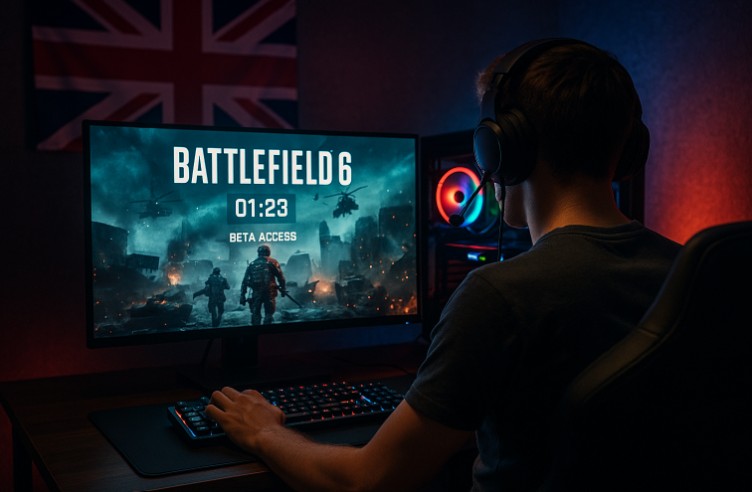The Flip 7 card game is quickly becoming a favourite among families and casual gamers across the UK. With simple rules, quick setup, and engaging gameplay, it offers the perfect balance between strategy and luck.
Whether you’re new to card games or a seasoned player looking for something fresh, Flip 7 delivers high replay value and fast-paced fun. This guide explores how to play, the official rules, and the most effective strategies to help you master the game.
What Is the Flip 7 Card Game and Why Is It Gaining Popularity?
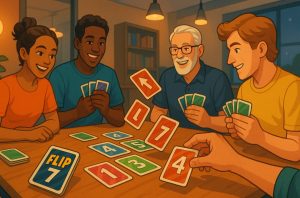
Flip 7 is a quick, engaging card game where players aim to avoid revealing the 7 card during gameplay. With simple rules and a fast-paced structure, it has gained popularity among UK families and casual gamers.
The unpredictability created by the appearance of 7s and the need for careful decision-making make the game exciting from start to finish.
Developed by Asmodee UK, Flip 7 is ideal for players aged eight and above. Its compact format and straightforward gameplay allow for spontaneous sessions that don’t require a major time commitment.
Players appreciate how it combines a sense of risk with accessible mechanics, making it suitable for both new and experienced gamers.
How Do You Set Up the Flip 7 Card Game?
Setting up Flip 7 requires minimal preparation, which contributes to its growing appeal. A shuffled deck and a handful of cards are all that’s needed to get started.
- The game includes a deck of custom Flip 7 cards.
- Shuffle the deck thoroughly before each game to ensure fair distribution.
- Deal five cards to each player. In games with a larger group, this number may be adjusted to ensure balance.
- Determine who goes first, commonly decided by who holds the highest card or chosen at random.
Once the setup is complete, players sit in a circle and take turns flipping cards from their hand, placing them in the centre pile.
What Are the Official Rules of the Flip 7 Card Game?

Flip 7 operates on a turn-based structure where each player attempts to avoid revealing a 7 card. The game uses a central flipping mechanic where cards are played face-up into a shared pile. On their turn, a player chooses one card from their hand to flip.
If a player flips a 7, they must draw another card from the deck. Should the newly drawn card also be a 7, the cycle continues. This can leave a player with a bloated hand or in an unfavourable position, especially late in the game.
Play continues until one of the following conditions is met:
- A player has flipped all cards in their hand
- Only seven cards remain in the deck
When the game ends, the player with the fewest 7s flipped is the winner. If multiple players tie on that score, further tie-breaking rules may be agreed upon before the game begins.
How Do You Play Flip 7 Step by Step?
Flip 7 operates with a straightforward turn-based format that keeps the pace brisk while giving players room to strategise.
Each player attempts to play all their cards while avoiding the penalties that come with revealing a 7. Despite its simplicity, the game has key phases that influence how each round unfolds.
Step 1: Start with a well-shuffled deck
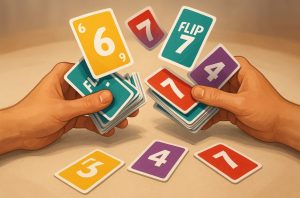
Before the game begins, all cards must be thoroughly shuffled. This is crucial to maintaining the element of surprise that underpins the tension of the gameplay. Once shuffled, the cards are dealt typically five per player, though this number can be adjusted depending on group size.
Step 2: Flip your first card
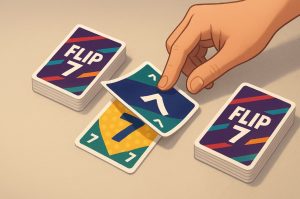
The player chosen to go first selects one card from their hand and flips it face-up onto the central pile. This continues clockwise, with each player taking a turn. Initially, the flips might seem harmless, but every turn increases the odds of a 7 appearing, which changes the flow of the game.
Step 3: Respond to a 7
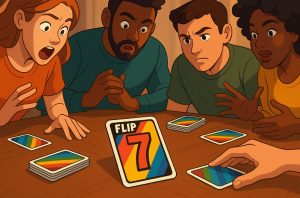
When a 7 card is flipped, the player who revealed it is immediately required to draw one additional card from the draw pile. If the new card is also a 7, the drawing continues until a non-7 is drawn. This mechanism can quickly expand a player’s hand and make it harder for them to finish first.
Repeatedly flipping 7s in a single round can lead to what players call a “7 chain” an unintended series of forced draws that may severely disadvantage a player, especially during the mid-to-late stages of the game.
Step 4: Maintain a strategic approach as the game progresses
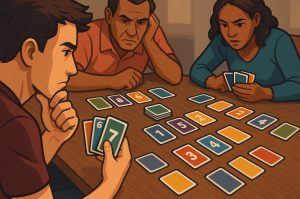
As cards are flipped and drawn, the size of the deck reduces, and players begin to adjust their strategies based on the cards already played. Some players might take a conservative approach, holding back cards they suspect to be 7s. Others may opt to push ahead, accepting the risks for a faster finish.
During this phase, it’s important to watch for subtle cues: players hesitating before a flip, keeping count of 7s already played, or strategically delaying their turns. This is the part of the game where psychological play and memory come into effect.
Step 5: Play until the end condition is met

The game ends when one of two outcomes occurs:
- A player successfully flips all of their cards without being eliminated by a 7 chain.
- There are only seven cards left in the draw deck.
At that point, all players tally the number of 7s they’ve flipped throughout the game. The player with the fewest 7s is the winner. If there’s a tie, players can either declare a draw or set up a final tiebreaker round using reduced hands.
The beauty of Flip 7 lies in how these simple steps evolve into an intense tactical challenge as players gain experience and begin to master the game’s pace, risk levels, and timing.
What Are the Best Strategies to Win at Flip 7?

Winning at Flip 7 takes more than luck. While the game’s randomness plays a role, long-term success depends heavily on observing patterns, making calculated decisions, and reading your opponents. Here are some of the most effective strategies that experienced players rely on.
Track the appearance of 7s
One of the most important habits to build is tracking how many 7s have already been flipped. Because the deck has a finite number of 7s, this information can help you assess the probability of drawing or flipping one yourself.
- If many 7s have already appeared early, the draw pile becomes safer.
- If few 7s are out, consider holding back aggressive plays.
Keeping a mental log of the 7s also helps you plan for the endgame, where every flip can become a pivotal decision.
Use bluffing and tempo to control the game flow
While not a traditional bluffing game, Flip 7 still offers opportunities to mislead opponents. Deliberate hesitation before flipping a card or confidently throwing one down can affect the psychology of your rivals.
By controlling tempo, either speeding up or slowing down your turns, you may pressure other players into mistakes, such as flipping a risky card or drawing prematurely.
Manage your hand to reduce risks
Hand management becomes more important as the game progresses. If you’re holding multiple cards suspected to be 7s (from past games or educated guesses), you’ll want to avoid being forced into back-to-back plays.
Tips for managing your hand:
- Balance risk across turns instead of saving all potential 7s until the end.
- Space out your risky cards between safer ones to reduce draw chains.
- Use safer turns to bait other players into being the first to flip a 7.
Adapt your strategy based on the number of players
With more players, the pace becomes unpredictable. The likelihood of someone flipping a 7 increases, and the draw pile can vanish quickly. In these games, it’s beneficial to play slightly more aggressively early on to avoid being stuck with a large hand near the end.
In smaller groups, the strategy shifts towards precision. You’ll need to focus on observation, tracking individual behaviour, and playing reactively.
Strategic Overview Table:
| Strategic Area | Description |
| Card Tracking | Observe how many 7s have been played to calculate draw risks |
| Turn Timing | Avoid drawing when the probability of hitting a 7 is high |
| Hand Structuring | Position your risky cards between safer options to minimise 7 chains |
| Opponent Observation | Watch body language and hesitation to anticipate risky moves |
| Deck Awareness | Track how many cards remain to plan your endgame more effectively |
Know when to press and when to hold
At times, you may find yourself with few cards left and no 7s flipped. This is an ideal situation to push forward quickly and finish the game before anyone else can recover. However, if you’re ahead but still holding a 7, consider slowing down to force other players into risky situations.
Learning this timing is critical. Players who consistently win are those who can switch between aggression and patience based on the current state of play.
Play the long game
The final strategy is mental endurance. Flip 7 is a game of streaks and surprises. Sometimes, you may be ahead for most of the round, only to be pulled into a losing streak of drawn 7s. Staying calm and disciplined, especially when behind, allows you to remain competitive and take advantage of your opponents’ mistakes.
Players who rush or get frustrated are more likely to miscalculate risk. The best way to win Flip 7 consistently is to remain focused, flexible, and observant from the first flip to the last.
How Is Flip 7 Different from Other Popular Card Games?
Flip 7 distinguishes itself through its “flipping” mechanic and the power of the 7 card. Unlike many traditional card games, Flip 7’s outcome can shift dramatically within a single round due to one card’s effect.
In comparison to other casual card games commonly played in the UK, Flip 7 is:
- More unpredictable, as any card flip may result in a setback
- Faster to play, typically taking less than 30 minutes per session
- Designed with a core mechanic that centres around escalation and risk
Comparison of Flip 7 with Other Games
| Feature | Flip 7 | Uno | Skip-Bo |
| Core Mechanic | Avoid flipping 7s | Match colours/numbers | Sequential card play |
| Average Duration | 20–30 minutes | 30–45 minutes | 30–60 minutes |
| Complexity | Low to moderate | Low | Moderate |
| Group Suitability | 3+ players | 2–10 players | 2–6 players |
| Strategic Depth | Moderate | Low to moderate | High |
Flip 7’s structure means that even first-time players can be competitive, but returning players can build nuanced strategies over time.
Can Flip 7 Be Enjoyed by Families and Groups?

Flip 7 is well-suited to a broad range of players and is especially ideal for family game nights or group play. It supports at least three players and becomes more dynamic with more participants. With an age recommendation of 8+, children and adults can enjoy it together.
The short setup time and accessible rules make Flip 7 a strong choice when time is limited or when introducing new players to the hobby. Social interaction, quick rounds, and moments of surprise make it a favourite for mixed-age gaming groups.
Small groups will benefit from a tighter strategy, while larger groups can expect a more chaotic and unpredictable play style. This balance adds to the game’s replayability and ensures that no two sessions feel exactly the same.
Where Can You Buy or Play the Flip 7 Card Game in the UK?
Flip 7 is available at a range of online and high-street retailers across the UK. Availability includes physical boxed editions and occasional promotional bundles offered by the publisher.
Retailers offering Flip 7 include:
- Asmodee UK’s official website
- Amazon UK
- Waterstones
- Zatu Games
- Independent board game shops
For those interested in trying the game before purchasing, several board game cafés across major UK cities offer Flip 7 as part of their demo libraries. Events or family game nights hosted by community centres may also include it as part of their gaming selection.
What Do Players Think About Flip 7? (Reviews & Feedback)

Reviews of Flip 7 consistently highlight its fun factor and tension-filled moments. The core mechanic involving the 7 card keeps players on edge and makes for engaging gameplay.
Player Feedback Highlights:
- Easy to learn and ideal for new gamers
- Engaging and fast-paced with little downtime
- The suspense of flipping cards adds excitement
- Can be played in short sessions, which suits busy schedules
Some reviews note that the game relies partly on luck, which may not appeal to those who prefer deeper strategic control. However, most agree that the lighthearted nature and group dynamics more than make up for it.
Many players also appreciate the game’s portability. Flip 7 is compact enough to take on holidays, to social events, or into classrooms for end-of-term fun.
Frequently Asked Questions About the Flip 7 Card Game
Is Flip 7 suitable for young children?
Yes, Flip 7 is designed for players aged eight and above. It’s simple enough for younger players to understand while still being engaging for adults.
How long does an average game of Flip 7 last?
Most rounds last between 20 and 30 minutes, making it an excellent choice for short, fun gaming sessions.
Can you play Flip 7 with just two players?
While technically possible, the game is best with three or more players to ensure a more dynamic and competitive experience.
Are there any expansion packs or variations?
As of now, Flip 7 does not have official expansions, but house rules and gameplay tweaks are common among frequent players.
Do I need any prior card game experience to play Flip 7?
No prior experience is required. The rules are easy to grasp, even for players who are new to card games.
Where can I find a printable Flip 7 rulebook?
You can download the official rulebook from Asmodee UK’s website or check inside the physical game box.
How do tie-breakers work in Flip 7?
In case of a tie, players may agree on a rematch or use the total number of cards flipped as a tiebreaker.



